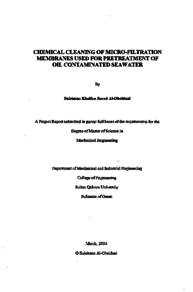وثيقة
Chemical cleaning of micro-filtration membranes used for pretreatment of oil contaminated seawater.
الناشر
Sultan Qaboos University
ميلادي
2004
اللغة
الأنجليزية
الملخص الإنجليزي
Oil removal from contaminated seawater is one of the major challenges facing the reverses osmosis (RO) desalination industry, particularly in oil producing regions such as the Arabian Gulf. In order to prevent fouling of RO membranes, oil must be removed from the feed water using a pretreatment step such as micro-filtration (MF) membranes. However, the MF membranes will then need to be cleaned periodically or they will also stop functioning.
The aim of this study was to develop a suitable procedure for cleaning MF membranes that have been employed for removal of oil from contaminated seawater. Specifically the influences on permeate flux of different types of cleaning agents (i.e. acidic and alkaline) for the MF membranes were investigated. The results showed that after cleaning with an acidic cleaning agent, the permeate water flux significantly increased, initially. However, the flux decreased continuously with time. On the other hand, the permeate water flux after membrane cleaning with alkaline agent increased but not as much as with the acidic cleaning agent. However, there was no significant decrease in flux with respect to time.
The experiments showed that the best membrane performance after the chemical cleaning was obtained when both chemical agents were used sequentially in the cleaning process. The permeate flux and operating cycle time recovery after chemical cleaning using both agents sequentially were 94.4% and 96%, respectively. In addition, the effects of reducing the soaking time during chemical cleaning was assessed. The results showed that a short soaking time (8-10 hours) may used in the case of small capacity MF membrane plants of one tray, and a longer soaking time (30 hours or more) may be used for large capacity MF membrane plants of more than one tray of membranes.
The Scanning Electron Microscopy (SEM) membrane surface analysis showed that in case of the alkaline cleaning agent, most of the pores remained covered with a foulant layer, resulting in low flux recovery. On the other hand, the SEM results of the acid cleaned membranes showed more complete removal of the foulant layer from the pores resulting in better flux recovery. The SEM surface analysis of membranes cleaned with the combined acid/base cleaning agents showed the best results by giving a membrane surface similar to the original one.
المجموعة
URL المصدر
الملخص العربي
إزالة النفط المتسرب في مياه البحر يعد من أحد أكبر التحديات التي تواجه عملية تحلية المياه بواسطة التناضح العكسي، وبالأخص في المناطق المنتجة للنفط مثل الخليج العربي. و لحماية أغشية التناضح العكسي من التلوث، يجب إزالة النفط من المياه المغذية للأغشية بواسطة المعالجة الأولية مثل استخدام الأغشية الدقيقة. ومع ذلك، هذه الأغشية الحقيقة سوف تحتاج إلى التنظيف بشكل دوري أو إنها سوف تتوقف عن العمل. الهدف من هذه الدراسة هو تطوير نهج مناسب لتنظيف الأغشية الحقيقة التي استخدمت لإزالة النفط من مياه البحر. وبشكل أكثر تفصيلا، تم اختبار تأثير أنواع مختلفة من المنظفات الكيميائية (أحماض و قلويات) على كمية ناتج التصفية للأغشية الحقيقة أظهرت النتائج أنه بعد عملية التنظيف باستخدام المنظفات الحمضية، كمية المياه الناتجة من التصفية ازدادت بشكل ملحوظ في البداية، ولكنها انخفضت بشكل متواصل مع مرور الوقت. وفي المقابل، كمية المياه الناتجة بعد تنظيف الأغشية بالمنظفات القلوية، ارتفعت ولكن بكمية أقل من حالة استخدام المنظفات الحمضية و لكن لا يوجد انخفاض كبير في كمية الناتج مع الوقت.
أظهرت التجارب أن أفضل أداء للأغشية الحقيقة بعد التنظيف الكيميائي كانت بعد استخدام المنظفات الحمضية و القلوية معا بالتناوب في عملية التنظيف. نسبة كمية المياه الناتجة كانت % 4, ۹۶ بينما كانت نسبة زمن دورة التشغيل % ۹۹ بعد استخدام المنظفين معا. بالإضافة إلى ذلك، تم تقييم تأثير زمن نقع الأغشية بالمنظفات الكيميائية خلال عملية التنظيف الكيميائي. حيث أظهرت النتائج انه يمكن استخدام زمن قصير النقع (۸-۱۰ ساعات) في المحطات ذوات السعة الصغيرة، وزمن نقع اطول (۳۰ ساعة أو أكثر) في حالة المحطات ذوات السبعة الكبيرة تحاليل المجهر الإلكتروني أظهرت أنه في حالة استخدام المنظفات القلوية، أغلب مسام الأغشية بقيت مغطاة بالطبقة الملوثة، مما أدى إلى كمية ناتج قليلة. وفي المقابل، تحاليل المجهر الإلكتروني لأغشية دقيقة منظفة باستخدام المنظفات الحمضية أظهرت عملية إزالة أكثر تكاملا للطبقة الملوثة مما نتج عنه كمية ناتج أفضل. أما تحاليل المجهر الإلكتروني للأغشية المنظفة بالمنظفات الحمضية و القاعدية معا بالتناوب، أظهرت أفضل النتائج بالحصول على سطح شبية بالسطح الأصلي للأغشية الجديدة.
أظهرت التجارب أن أفضل أداء للأغشية الحقيقة بعد التنظيف الكيميائي كانت بعد استخدام المنظفات الحمضية و القلوية معا بالتناوب في عملية التنظيف. نسبة كمية المياه الناتجة كانت % 4, ۹۶ بينما كانت نسبة زمن دورة التشغيل % ۹۹ بعد استخدام المنظفين معا. بالإضافة إلى ذلك، تم تقييم تأثير زمن نقع الأغشية بالمنظفات الكيميائية خلال عملية التنظيف الكيميائي. حيث أظهرت النتائج انه يمكن استخدام زمن قصير النقع (۸-۱۰ ساعات) في المحطات ذوات السعة الصغيرة، وزمن نقع اطول (۳۰ ساعة أو أكثر) في حالة المحطات ذوات السبعة الكبيرة تحاليل المجهر الإلكتروني أظهرت أنه في حالة استخدام المنظفات القلوية، أغلب مسام الأغشية بقيت مغطاة بالطبقة الملوثة، مما أدى إلى كمية ناتج قليلة. وفي المقابل، تحاليل المجهر الإلكتروني لأغشية دقيقة منظفة باستخدام المنظفات الحمضية أظهرت عملية إزالة أكثر تكاملا للطبقة الملوثة مما نتج عنه كمية ناتج أفضل. أما تحاليل المجهر الإلكتروني للأغشية المنظفة بالمنظفات الحمضية و القاعدية معا بالتناوب، أظهرت أفضل النتائج بالحصول على سطح شبية بالسطح الأصلي للأغشية الجديدة.
قالب العنصر
الرسائل والأطروحات الجامعية

